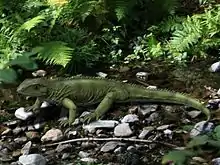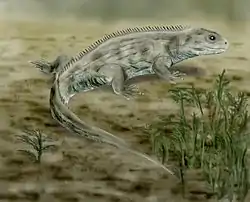Gephyrosaurus
Gephyrosaurus is a genus of early rhynchocephalian first described and named in 1980 by Susan E. Evans.[1] They are distantly related to the extant Sphenodon (tuatara of New Zealand) with which they shared a number of skeletal features including a large tooth row along the side of the palatine bone (part of the palate) and posterior process of the dentary bone (part of the lower jaw). The type species, G. bridensis, lived during Early Jurassic in Wales, UK.[2][3][4][5][6][7][8][9][10] Whiteside & Duffin (2017) described the second species, G. evansae, known from a partial maxilla recovered from Late Triassic (Rhaetian) fissure fills in Carboniferous Limestone in Somerset.[11] They are the only rhynchocephalians to lie outside Sphenodontia in modern definitions of the group, and have been found to be more closely related to squamates in some phylogenetic analyses.[12]
| Gephyrosaurus | |
|---|---|
 | |
| Life reconstruction of G. bridensis | |
| Scientific classification | |
| Kingdom: | Animalia |
| Phylum: | Chordata |
| Class: | Reptilia |
| Order: | Rhynchocephalia |
| Family: | †Gephyrosauridae |
| Genus: | †Gephyrosaurus Evans, 1980 |
| Type species | |
| †Gephyrosaurus bridensis Evans, 1980 | |
| Other species | |
| |
Anatomical Description
Limbs
Observation of the skeletal elements of Gephyrosaurus bridensis makes it evident that this was very much a lizard-like creature.[2] It possessed relatively long, slender legs which would allow it to run quickly in pursuit of prey or in escape from larger predators.[2] While many small lizards are able to climb trees, it is possible this organism was not fully arboreal although it possessed strong legs and claws which would make it possible to climb.[2] It is unlikely Gephyrosaurus was bipedal.[2]
Vertebrae
Two distinct vertebrae from Gephyrosaurus bridensis were described, and these vertebrae are very similar to the modern Rhychocephalian Sphenodon, providing strong evidence that the two genera are related [2]
Dentition
Gephyrosaurus bridensis possessed pleurodont dentition that is believed to have replaced slowly during the animal's lifetime.[5] In her 1985 paper, Evans suggests that this could be the ancestral state for tooth replacement in lepidosaurs.[5]
Behavior
Gephyrosaurus was a terrestrial reptile and is assumed to be an insectivore that used a patient feeding strategy as it waited for prey to arrive.[4] High incidence of jaw fractures found among specimens infers that this animal was potentially territorial and would attack those who crossed into their home range.[4]
References
- Evans, S.E. 1980. The skull of a new eosuchian reptile from the Lower Jurassic of South Wales. Zoological Journal of the Linnean Society 70: 203–264.
- Evans, Susan E. (1981). "The postcranial skeleton of the Lower Jurassic eosuchian Gephyrosaurus bridensis". Zoological Journal of the Linnean Society. 73 (1): 81–116. doi:10.1111/j.1096-3642.1981.tb01580.x.
- Evans, S.E. 1981. Caudal autonomy in a lower Jurassic Eosuchian. Copeia 1981: 883-884.
- Evans, Susan E. (August 16, 1983). "Mandibular Fracture and Inferred Behavior in a Fossil Reptile". Copeia. 1983 (3): 845–847. doi:10.2307/1444363. JSTOR 1444363.
- Evans, Susan E. (1985). "Tooth replacement in the Lower Jurassic Lepidosaur Gephyrosauru bridensis". Neues Jahrbuch für Geologie und Paläontologie. 1985 (7): 411–420. doi:10.1127/njgpm/1985/1985/411.
- Evans, S.E. 2003. At the feet of the dinosaurs: the early history and radiation of lizards. Biological Reviews, 78:513-551. doi:10.1017/S1464793103006134
- Jones, M.E.H. 2008. Skull shape and feeding strategy in Sphenodon and other Rhynchocephalia (Diapsida: Lepidosauria). Journal of Morphology 269: 945–966. doi:10.1002/jmor.10634
- Gill, P.G., Säilä, L.K., Corfe, I.J., Challands, T.J., Williams, M., Clemens, W.A. 2006. The fauna and palaeoenvironment of St. Brides Island: Evidence from the lower Jurassic fissure fills of South Wales. In Ninth international symposium on Mesozoic terrestrial ecosystems and biota. (ed. P. M. Barrett & S. E. Evans), pp 48−51. London: Natural History Museum.
- Jones, M.E.H. 2009. Dentary tooth shape in Sphenodon' and its fossil relatives (Diapsida: Lepidosauria: Rhynchocephalia). In Koppe, T., Meyer, G., Alt, K.W., eds. Interdisciplinary Dental Morphology, Frontiers of Oral Biology (vol 13). Greifswald, Germany; Karger. 9–15.
- "Archived copy". Archived from the original on 2010-03-06. Retrieved 2010-03-03.CS1 maint: archived copy as title (link)
- David I. Whiteside, FLS; Christopher J. Duffin, FLS (2017). "Late Triassic terrestrial microvertebrates from Charles Moore's "Microlestes" quarry, Holwell, Somerset, UK". Zoological Journal of the Linnean Society. 179 (3): 677–705. doi:10.1111/zoj.12458.
- Simões, Tiago R.; Caldwell, Michael W.; Pierce, Stephanie E. (December 2020). "Sphenodontian phylogeny and the impact of model choice in Bayesian morphological clock estimates of divergence times and evolutionary rates". BMC Biology. 18 (1): 191. doi:10.1186/s12915-020-00901-5. ISSN 1741-7007. PMC 7720557. PMID 33287835.

